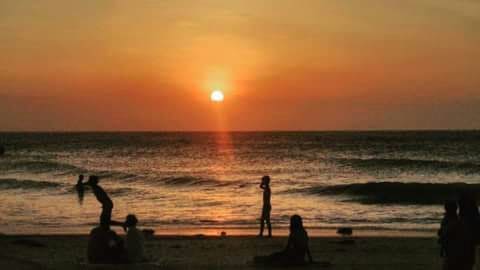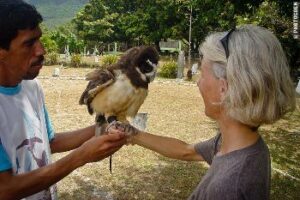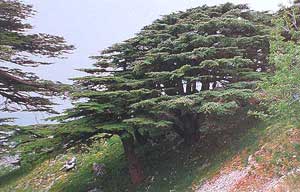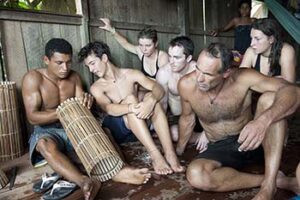
Jeri, on Brazil’s Northeast Coast, Has a Way of Grabbing You
By Johnny Motley

In 2008, I arrived in Jericoacoara, Brazil for the first time, a trip requiring a 20-hour, multi-connection flight from Boston to Fortaleza, an eight-hour bus ride from Fortaleza to Jijoca, and finally, a 90-minute jaunt in an enormous, painted dune-buggy over mountains of powdery sand.
That trip was one of the most transformative episodes of my life. This is not hyperbole: when I look back on my days as an old man, I’ll probably say the same. Jeri is simply spellbinding.
Enamored with the Village
Being an adolescent, upper-middle-class suburbanite from the US, I was entranced by this isolated Brazilian village.
The locals lived joyfully without any of the material comforts that I had been taught were non-negotiable. Experiencing this, I came to question the very core of my values and reevaluated what I wanted out of life.
Gorgeous Surfer Girls
The hypnotically beautiful sunsets, tropical beaches, and the gorgeous Brazilian surfer girls (probably most memorable of all to my 18-year-old self) kept me dreaming for years of returning. Finally, after graduating from college, I decided to go for it; I bought a one-way ticket to Fortaleza and moved to Jericoacoara, earning my bread as an English teacher and bartender.
Jericoacoara, a Wind Sports Hot Spot
Jericoacoara is recognized as one of the best places in the world for wind sports, an accolade that transformed it in the 1980s from a poor subsistence fishing village to a hard-to-reach Shangri-La beckoning bleary-eyed surfers, musicians, and hippies. In those early days of tourism, setting foot in Jeri still necessitated an arduous trek and roughing it without electricity or hot water.
Around the early 2000s, Jeri underwent a second transformation, this time from a sleepy surf town to a full-blown international holiday destination, with the majority of the village bought up by wealthy foreigners.
Garden of Eden
An airport was completed nearby in 2016, thus forever ending the isolation that kept Jeri a bit of a secret Garden of Eden.
I was only there for two weeks for my first visit but dreamed of returning. Finally, after graduating from college, I decided to go for it and moved to Jericoacoara.

Now ranked as the third most popular tourist destination in Brazil, the idyllic village has become a chic, Instagram-worthy destination, boasting some of the finest hotels and restaurants in South America.
Wash Ashores
In spite of these changes, lamented by some, the soul of Jeri as a paradise at the end of the world somehow persists.
Jericoacoara’s Nightlife

Jeri punches well above its weight in terms of nightlife. The bars, restaurants, and hotels hugging the beach keep the party going until sunrise or later most of the week.
The best way to begin the evening is to climb the Duna do Sol (a Himalayan-sized sand dune towering next to the ocean) around 5 p.m. to marvel at one the most famous sunsets in the world.
Around dusk, the locals, and even some highly-trained foreigners perform amazing feats of athleticism performing capoeira, a Brazilian martial art that originated from enslaved Africans.
After dinner at one of Jeri’s fantastic restaurants, check out the forró, accordion-laced dance music popular throughout Brazil. Twice-weekly (Mondays and Fridays), a live band plays forró on the sandy-floored dance hall of Dona Amelia—an unforgettable experience.
Listen to the Forró
After dinner and at one of Jeri’s fantastic restaurants, check out the forró, accordion-laced dance music popular throughout Brazil. Twice-weekly (Mondays and Fridays), a live band plays forró on the sandy-floored dance hall of Dona Amelia.
Speaking of live music, there is no shortage of Brazil’s most beloved musical style, samba. Long renowned as an artists’ haven, some of Brazil’s finest musicians come to jam in Jeri.
Ask around Tortuga Bar to find out where the samba will be on any particular night. With a caipirinha in hand, these joyful melodies will banish your blues.

Ask around Tortuga Bar to find out where live samba will be any particular night. With a caipirinha in hand, the joyful melodies of samba will banish any blues.
Enjoying Wind Sports in Jericoacoara
With its eternal breezes and ideal water conditions, Jeri first gained international fame as one of the best destinations in the world for windsurfing and kitesurfing. Nowadays, stand-up paddleboarding is also a major attraction.
Gaia, a windsurf rental outfit right on Jeri’s principal beach, can hook you up quickly with gear and lessons. Ask for Alvaro, the old white guy in a hammock chair at the front of the shop drinking yerba maté.
 Kitesurfing agencies have multiplied in recent years as the sport gained popularity. The gear rental and lessons are damned expensive, even in Brazil; shop around for prices and packages.
Kitesurfing agencies have multiplied in recent years as the sport gained popularity. The gear rental and lessons are damned expensive, even in Brazil; shop around for prices and packages.
Don’t be afraid to negotiate: as a tourist, the instructors will try to rip you off at first, so don’t be a push-over.
National park excursions and day trips
Located on one of Brazil’s largest national parks and surrounded by sand dunes and ocean, there is no shortage of hiking and dune-buggy exploration around Jericoacoara.
Numerous fishing villages and lagoons dot the hinterland around the village, where you can enjoy fresh seafood, cachaça, and hours chillin’ in hammocks over crystalline water.
For an afternoon of blissful tranquility, head to the Laguna do Paraíso (Paradise Lagoon) or, a bit further out, to the small town of Tatajuba. As long as you patronize one of the restaurants you relax for the afternoon in one of the numerous hammocks constructed over the turquoise shallow water.
A book, a guitar, and some friends are all you need. With an ice-cold Brazilian pilsner at hand, a more golden afternoon does not exist. Not anywhere.
Hiring a Private Dune Buggy and Driver
For around $20-30USD, you can also hire a private dune-buggy driver to show you around the national park and the surrounding villages. The tours generally last about 6-7 hours, during which time you’ll see the national park and have lunch in some small, beachy restaurant. The fresh seafood, especially the shrimp and oysters, is seasoned with nothing more than a touch of garlic, lime, and parsley—just exquisite.

The surrounding villages, such as Preá and Tatajuba, still function primarily as sustenance fishing and farming communities and receive only a fraction of the tourism that Jeri does.
They are rougher around the edges but still have pousadas, Brazilian-style boutique hotels, and decent restaurants for a fraction of the price you’d pay in Jeri.
Festivals and Best Times to Visit
Like New Orleans, Jericoacoara is perpetually either planning for or recovering from a festival.
The major Brazilian holidays of Carnaval and São João attract sizable crowds, but, frankly, there are better places in the Northeast to enjoy the revelries of these national holidays (e.g., Salvador da Bahia or Recife). New Year’s Eve in Jericoacoara, during the peak of the Southern Hemisphere’s summer, is one of the highlights of the year.
For music aficionados, the Choro Jazz Festival attracts many of the most virtuosic sambistas and jazzists from across Brazil, and beyond. For a bacchanalian bender, there is a raging EDM festival each year, resembling Ultra-Fest teleported to a South American beach. In addition to festivals, Jeri hosts kitesurfing and windsurfing competitions during the windy season.
Best Wind in High Season
The high-season, when the wind is best, lasts roughly from June-December, and the city is overwhelmingly dominated by tourists during this time. During the low season from January-May, it rains most days (although usually for only an hour or so), and about half of the businesses in the village close down.
Personally, I prefer the latter; even though it’s slower and quieter, the local community really bonds during these months. Even during the subdued low-season, the weekends summon a good amount of visitors, mostly from Fortaleza, and bonfires light up the beach at night.
Long-term living
Increasingly, travelers have become so enamored with the dolce vita of Jericoacoara that they decide to live there long-term, renting apartments and finding employment. In 2013, I found a decent apartment–i.e., a clean, private, and attractive one-bedroom with a small kitchenette–for about $300 USD/month, all utilities included.
Local friendships, built after several months of living in Jeri, helped me find the place. Rent prices in 2020 are undoubtedly higher, but if you’ve saved up euros or dollars, you can still find bargain-priced, highly-livable apartments.
 Johnny Motley is a religious studies teacher, incorrigible wanderer, and aspiring writer and photographer. After graduating from Harvard College, he decided that being a responsible adult was not for him and has been scheming about how to continuously keep exploring the world ever since. Read more of his articles on johnnymotley.com and follow him on Instagram @motjohnny.
Johnny Motley is a religious studies teacher, incorrigible wanderer, and aspiring writer and photographer. After graduating from Harvard College, he decided that being a responsible adult was not for him and has been scheming about how to continuously keep exploring the world ever since. Read more of his articles on johnnymotley.com and follow him on Instagram @motjohnny.
- Missouri Sports Travel Adventure: From Landmarks to Ballparks - January 21, 2026
- What First-Time Visitors Get Wrong About Visiting Iceland - January 15, 2026
- Bareboat Charter vs all-inclusive Crewed: Which Luxury Charter Fits You? - December 29, 2025







